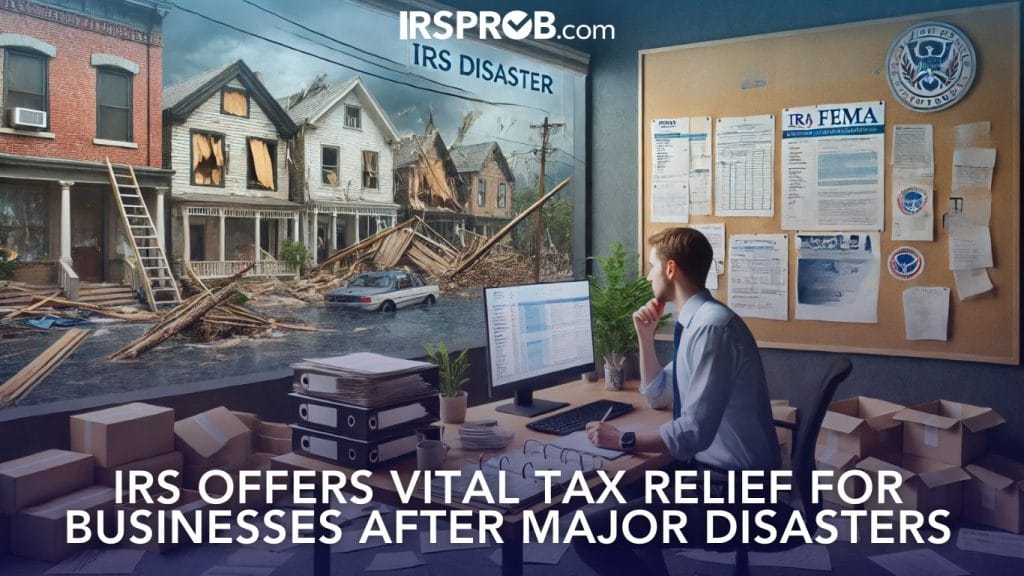
When disaster strikes, the financial burden on businesses can be overwhelming. Thankfully, the IRS provides tax relief to businesses and individuals affected by federally declared disasters. This relief can help business owners navigate the aftermath, ensuring they can recover more efficiently and protect their financial health. Let’s break down what business owners need to know about disaster tax relief and how to take advantage of it.
How Does IRS Disaster Relief Work?
The IRS offers various forms of tax relief after a major disaster is declared by the President. These relief efforts are generally triggered when the Federal Emergency Management Agency (FEMA) identifies specific regions eligible for assistance under its Individual Assistance program. Once FEMA declares an area eligible, the IRS extends special tax relief provisions to business owners in those regions.
Key IRS Disaster Relief Measures for Businesses
- Extended Deadlines for Filing and Paying Taxes
Business owners located in federally declared disaster areas automatically receive additional time to file tax returns and pay any taxes owed. This extension applies even if the business wasn’t directly affected by the disaster but is located in the qualifying region. The IRS typically posts updates about the length of these extensions on its disaster assistance webpage, and business owners can also contact the IRS directly at their disaster hotline for more specific guidance. - Casualty Loss Deduction
If your business has suffered property damage due to a disaster, you may qualify for a casualty loss deduction. This allows businesses to claim a deduction for damaged or lost property on their tax return. A unique benefit of this deduction is that it can be claimed on either the current year’s return or the prior year’s return, potentially leading to a larger refund at a critical time. It’s important to assess the impact of this deduction carefully, as it can significantly reduce your tax burden in a disaster year. - Disaster Loans and Grants
In addition to tax relief, business owners affected by disasters may also qualify for financial assistance through loans or grants provided by the Small Business Administration (SBA). However, to be eligible for these programs, you must be current with your tax filings. If your tax records were lost or damaged during the disaster, you can request expedited copies of your tax returns from the IRS to meet this requirement.
What Business Owners Should Do After a Disaster
After a disaster, managing your business’s recovery can feel daunting, but the IRS offers several tools to help you navigate this process. Here’s a step-by-step guide on what to do:
- Obtain Necessary Tax Records
To file claims or apply for disaster-related assistance, you may need a copy of your tax records. The IRS provides free tax transcripts, which you can access online using the Get Transcript tool, or you can request them by phone or mail. For a complete copy of your tax return, you can file Form 4506, and the IRS will waive the usual fees in cases of disaster-related requests. - Claim a Casualty Loss
If your business experienced significant property loss, claiming a casualty loss deduction can be a lifeline. You can opt to claim the loss on your prior year’s tax return, which may expedite your refund, providing much-needed liquidity during recovery. - Notify the IRS of Any Address Changes
If your business needs to temporarily relocate after a disaster, make sure to notify the IRS of your new address. You can do this by submitting Form 8822, Change of Address, or calling the IRS Disaster Hotline. This ensures that all future tax correspondence and disaster-related communications reach you without delay.
Additional Resources for Disaster Relief
In addition to IRS tax relief, businesses can explore a variety of federal and state resources for disaster assistance. FEMA’s DisasterAssistance.gov provides a comprehensive list of available relief programs, including grants, loans, and other financial support for businesses facing hardship due to a disaster.
The IRS regularly updates its website with information about new disaster declarations and the specific relief available for each region. Business owners should make it a priority to stay informed and explore all potential avenues for recovery.
Planning Ahead for Future Disasters
While no business owner likes to think about future disasters, preparing for them can make recovery much smoother. Consider reviewing your business’s insurance coverage to ensure it includes disaster-related protections. Keep digital backups of all tax records and critical business documents, as accessing these records quickly is essential during disaster recovery.
By understanding and utilizing the IRS’s disaster relief programs, business owners can alleviate some of the financial stress that comes with unexpected disasters. The IRS’s tax relief efforts, paired with other available government resources, ensure that businesses have the support they need to get back on their feet and continue operating successfully.









